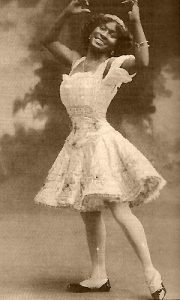Topsy has had quite the afterlife. Beyond the page, she was consumed on a mass scale by white audiences, performed by both white (in blackface) and black artists such as Ida Forsyne, and is credited with inspiring black artistry especially that associated with body movements.
A scholar, Jayna Jennifer Brown, commented on Topsy, saying, “Topsy is framed and developed in the novel as a transnational figure for the heathen native. This was part of the reason why the English responded so readily to the character.” (Topsy became a national traveling act during the Vaudeville period) One might even conclude that the bathing of Topsy when she arrived into the hands of Miss Ophelia, was her Baptism of sorts, an initiation into a devout existence of reform, English academics, and subservience.Stowe presents her Western readership with Topsy, a primitive, uncivilized being described as, “goblin-like” and “heathenish”. (UTC 202)
It is during this bathing that we are introduced to Topsy’s body as an object of historic and consistent abuse. Permanent marks are left from years of beatings, scarred skin, a darkened surface….
Topsy is a child- to be so young with so much trauma. That’s not a trope. It is true of so many childhoods of the time, and quite honestly, still remains true of children around the world today.
Anyway, what are we take make of this little girl’s body? It isn’t smooth and white as one might imagine Eva’s body, but disfigured and marked up like property. I would like to explore whether or not that has anything to do with her being regarded as heathen. If her body was unscarred, her hair of a different texture, her presentation a little cleaner, would she be worthy of less pity and more relatability? Even more than her physical appearance, I wanted to consider her performance via her body. There is a long history of blacks using their bodies as a way to redefine their freedom- to escape and defy. Does Stowe’s presentation of Topsy fit this framework? What of Topsy’s body? Is she free?
Two modes of thought have grown from her character:
- Topsy is an embarrassment to a black race that is trying to overcome comic mockery of cultural habits. New freedoms brought a desire for a new image- an image that reflected greater dignity. Topsy’s lasting cultural impact, was a disgrace to that hope. In a 1935 article, Montgomery Gregory put it this way, “Although Uncle Tom’s Cabin passed into obscurity, Topsy, survived. She was blissfully ignorant of any ancestors, but she has given us a fearful progeny. The earliest expression of Topsy’s baneful influence is to be found in the minstrels…these comedians, made up into grotesque caricatures of the Negro race, fixed in the public taste a dramatic stereotype of the race that has been almost fatal to a sincere and authentic Negro drama.”
Those are some pretty harsh words for a character that isn’t even living. What I can’t understand is why Topsy is to blame. There were many a black artist (REAL, living, breathing black artists) who played into the same minstrel stereotype that was just as detrimental to the black image. Topsy represented a black youth who had no history to claim (father, mother, home) and little regard for respectable decorum. That was part of her freedom. Her performance was one of physical and mental survival…
- Topsy’s character performance is one of freedom. Perhaps, you could look at her like a farce, but one must also consider her ability to remain unmoved by any punishment forced upon her. Her impenetrableness to pain indicates, “her body is resistant to violent claims of ownership. “- Jayna Brown
Her every movement, joke, theft, song, and facial expression makes manifest her authority over herself. Individual gestures of any nature can neither be bought nor sold.
I have been supremely impacted by this little Topsy girl. It made me think of all the ways in which I perform. Does the world see me as a foolish Topsy? Am I somehow a disgrace to the black image in the foods that I eat, my word choice or dialect, way I wear my hair, things I find funny. During the time, blacks were always dealing with a desire to protect and grow a more positive/empowered image. There was a rift between those attempting to shed controversial skins, skins related to “Uncle Tomism”, Topsy, Sambbo, Mammies, etc. and those maximizing off the economic gains of playing into such tropes. White people of the time, and even today, loved this foolery. To the uncritical eye, Topsy, breathed life into such stereotypes BUT more importantly, she took claim of a life that was denied to her. She made her own fun, her own games, her own joy.
And what of her body? It went beyond the vocabulary of Stowe, reconfigured expectations, and became a slate on which many can mark their experiences. Despite popular belief, there is no such thing as one dimensionality in regards to her character. She is all of the latter. As time moves forward, I do not doubt that she will come to be even more.
Check these visuals:
An angelic Topsy reclaiming her space with some watermelon and the cutest little grin vs. unloved Topsy being comforted by angelic Eva whose touch is supposed to save the day. I prefer watermelon angel Topsy.



